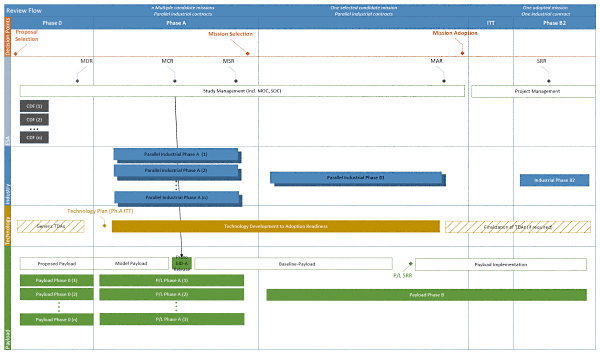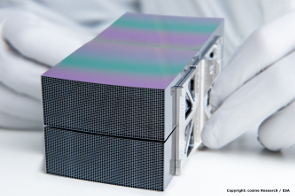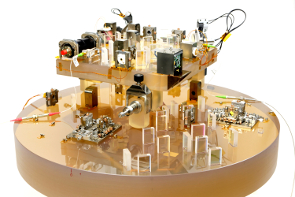Preparation of technologies for future science missions
Mission Preparation
New missions within ESA's Science Programme are proposed by the science community and follow a thorough competitive assessment process before being proposed for selection, and later adoption, by the Science Programme Committee (SPC).
 |
|
Mission preparation phases from proposal selection to mission adoption. Credit:ESA (Click here for larger version and additional information.) |
The Future Missions Department (SCI-F) within ESA's Directorate of Science (D/SCI) is responsible for the preparation of missions up to the end of Phase B1.
Technology Preparation
The Technology Preparation Section (SCI-FT) within the Future Missions Department (SCI-F) has the primary task of the identification and development of critical technologies required for future science missions. The aims of the section are achieved by working closely with the other sections in SCI-F and the rest of ESA, and also the ESA Member States.
Share of responsibilities for the Space Segment
The baseline assumption for ESA Science missions is that the procurement of the scientific instruments (payload) is performed by the ESA Member States. For solar and planetary missions, the payload is generally made up of an instrument suite provided by the Member States. For astrophysics and fundamental physics missions, the dividing line between ESA and Member States responsibilities is agreed on a case-by-case basis. In general, large and complex payload elements that are strongly interleaved with the spacecraft design are provided under ESA responsibility (for example, the complete Gaia instrument or the Euclid telescope), while focal plane instruments are often provided under the responsibility of Member States.
It is assumed that the Member States will be in charge of the technology developments required of the instruments they plan to provide, while ESA implements the technology developments related to the rest of the spacecraft and payload elements remaining under ESA responsibility.
 |
 |
| Silicon Pore Optics developed for enabling the L2 mission, Athena. Credit: cosine Research/ESA | Industrialisation of the manufacturing process of the optical bench for the L3 mission, LISA, has been enabled through ESA development activities. Credit: ESA |
Key steps in technology preparation
There are two major tasks in the process of preparing technologies for missions:
I. Identification of Technology Requirements
The mission preparation study phases (Phase 0, Phase A, and Phase B1) progressively develop the mission concept and the associated mission requirements, from which technology needs and technical requirements are derived and evolved.
As a general rule, a Technology Readiness Level 5-6 (in ISO scale) is expected for both the spacecraft elements and the payload by the end of Phase B1, prior to a mission being adopted. When TRL 5-6 is achieved for a given element, its feasibility, critical functions and overall performance are demonstrated in a mission-relevant environment. Reaching this level of technical maturity is considered essential for minimising the risk to cost and schedule for implementing a mission.
Critical technologies identified to be at TRL less than 5 (with respect to the specific mission under study) are reviewed and development plans are established for these technologies following the ESA End-to-End Technology Management Process.
The development of a required technology is executed through one or a series of ESA Technology Development Activities (TDAs). The activities are identified through inputs arising from:
- technology development needs identified through ESA internal studies;
- activities identified by industry in the course of industrial studies;
- activities identified by the science community through studies undertaken by institutes or consortia in parallel to the industrial studies.
II. Implementation of Technology Development Activities
All Technology Development Activities required for future Science missions are captured in the Science Programme Technology Development Plan. Technology Development Activities under ESA responsibility are mainly implemented through the Science Core Technologies Programme (CTP) or the basic activities Technology Research Programme (TRP).
The Technologies Research Programme is generally devoted to initial technology developments leading to an experimental verification of the feasibility of critical functions or to verification at breadboard level in a laboratory environment (TRL 3/4).
The Science Core Technologies Programme generally focuses on reaching a higher level of technology maturity by demonstrating the element performance in a mission relevant environment (TRL 5/6).
In many cases developments are started under TRP and are then pursued further under CTP.
The Technology Preparation Section (SCI-FT) works closely with ESA technical experts across all technology domains to elaborate the detailed technical work needed to realise the technology developments. The implementation of the TDAs managed by ESA technical experts is monitored by the Technology Preparation Section to ensure compatibility with the mission preparation schedule.
Further details about the Technology Development Activities within the Science Programme Technology Development Plan can be found here.
Information about research and development (R&D) opportunities and how to do business with ESA is available here.
